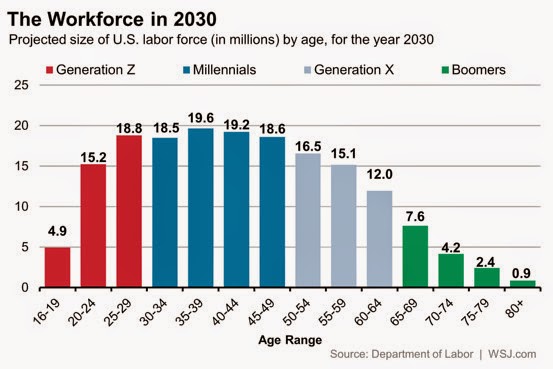 Journalist's Resource
Journalist's ResourcePolitical strategists and candidates will be well-served to keep their eyes on an important demographic shift while thinking about how to connect with Millennial generation voters.
In 2015, the Millennial generation — those ages 18 to 34, and born between 1981 and 1997 — is set to become larger than the Baby Boom generation. (This will be true, even as the country’s median age continues to rise.)
Over the next three decades or so, the cohort of Baby Boomers will decline in size steadily, and by mid-century only about 1 in 5 will be living, as the Pew Research Center points out.
As this giant post-war generation — the largest in U.S. history to this point — dwindles, so too will a defined set of news consumption habits that evolved around print newspapers and limited consumer broadcast choice. Meanwhile, a diverse new generation will come to maturity with a new set of embedded information, technology and communications practices and values.
A March 2015 report from the American Press Institute and the Associated Press-NORC Center for Public Affairs Research, “How Millennials Get News: Inside the Habits of America’s First Digital Generation,” draws new insights based on a survey of 1,046 members of the generation, as well as qualitative interviews in select cities. Working together as part of the Media Insight Project, the researchers set out to test some commonly held assumptions about Millennials — a highly digitally connected cohort — including that they are less interested in news than are past generations. The margin of error for the survey was plus or minus 3.8 percentage points.
The report’s findings include:
- Eighty-five percent of Millennials surveyed said keeping up with news is at least somewhat important to them, and 38% said it is “very” or “extremely” important. Forty-five percent said they follow five or more “hard news topics.”
- Just under two-thirds (64%) said they regularly follow what’s going on in the world and/or consume news articles or broadcasts.
- Among the activities that Millennials engage in online, accessing news ranks somewhere in the middle: “Keeping up with the news falls only slightly behind the three most popular digital activities: checking and sending email (72%), keeping up with what friends are doing (71%), and streaming music, TV, or movies (68%).”
- Among those surveyed, 88% said they get news from Facebook, while 33% said they get news from Twitter. “On 24 separate news and information topics probed, Facebook was the No. 1 gateway to learn about 13 of those, and the second-most cited gateway for seven others.”
- Millennials reported encountering a range of opinions among their online information sources, especially those who reported encountering news more casually or incidentally: “Fully 73% of those Millennials who say they mostly bump into news and information throughout their day say the opinions in their feeds are an even mix of viewpoints, compared with 65% of those who call themselves active news seekers. Bumping into news, in other words, may widen the perspectives one is exposed to, not narrow them.”
- There were differences between age cohorts within this generation: “Only a third of the youngest Millennials, those under age 25, describe themselves as mostly proactive news consumers. By contrast, fully half of those over age 30 do so. These older Millennials are evenly divided between those who mostly seek out news and those who mostly bump into it.”
Reposted from Journalist's Resource

No comments:
Post a Comment